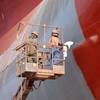By Edward Lundquist, Senior Science Advisor, Alion Science and Technology
Chief of Naval Operations (CNO) Adm. Gary Roughead answers questions during the 20th annual Surface Navy Association symposium. Roughead spoke on the important role that ships, submarines and aircraft play in the maritime strategy. (U.S. Navy photo by Mass Communication Specialist 1st Class Tiffini M. Jones)
Attendees at the 20th annual Surface Navy Association Symposium heard the message loud and clear: The Navy needs more ships.
The Surface Navy Association, founded in 1985 to "promote greater coordination and communication among those in the military, business and academic communities who share a common interest in naval surface warfare," held the three-day symposium at the Hyatt Regency in Arlington, Virginia. The theme of the symposium was “A ready and relevant Surface navy: An enterprise approach to warriors, ships and systems.”
“This year’s symposium comes at a time when the United States Navy is celebrating a great milestone in our history—the round-the-world cruise of the Great White Fleet that departed Hampton Roads in December 1907 under the admiring gaze of its mastermind: President Theodore Roosevelt,” said Secretary of the Navy Donald C. Winter, speaking at the SNA Symposium banquet.
Winter said that Roosevelt’s “audacious idea” of sending the fleet around the world was conceived in order to accomplish two major goals. “First of all, send a message to the world that America had arrived as a world power with global reach; and secondly, test and evaluate the fleet.”
Said Roosevelt, in a July 1907 letter, “It is high time [that the fleet] should go on a cruise around the world. In the first place I think it will have a pacific effect to show that it can be done; and in the next place…[it is] absolutely necessary for us to try in time of peace…and not make the experiment in time of war.”
The Great White Fleet also served as an early outreach effort to other nations, with port visits and diplomatic outreach wherever they sailed. “One year into the cruise, an unanticipated mission in response to a crisis also established a now long-standing U.S. Navy tradition in the area of disaster relief,” Winter said recently at a ceremony commemorating the beginning of the Great White Fleet voyage, held aboard the aircraft carrier USS Theodore Roosevelt in Norfolk.
Winter said that the Navy needs a balanced fleet. “Some missions—counter-piracy, for example—can be satisfied with low-end capabilities. But with 70 percent of the earth’s surface covered by water, 80 percent of the world’s population living near the world’s coastlines, and 90 percent of the world’s international commerce transported by sea, presence is more critical than ever. Presence matters, and for low-end capability missions such as counter-piracy and many other maritime security missions, it may be the dominant consideration. At the same time, some potential threats necessitate high-end capabilities that must match constant improvements in technology, as we have seen, for example, in Chinese submarines and missiles.”
“To achieve this balance,” Winter said, “ the U.S. will need more affordable ships, such as Littoral Combat Ships that can be tailored to the variety of missions we must be ready to carry out in the vast littoral regions."
To read the complete story, pick up a copy of the February 2008 edition of Maritime Reporter & Engineering News.
Subscribe for
Maritime Reporter E-News
Maritime Reporter E-News is the maritime industry's largest circulation and most authoritative ENews Service, delivered to your Email five times per week










